Mobile Cores for the Internet of Things
Learn how a distributed mobile core can help you meet the performance demands of an IoT solution, improve the latency of data transmission, and create a more seamless customer experience.
Mobile Cores for the Internet of Things
Learn how a distributed mobile core can help you meet the performance demands of an IoT solution, improve the latency of data transmission, and create a more seamless customer experience.
WHITEPAPER
Multi-IMSI SIM –
Your Key to a Successful Global Cellular IoT Deployment
Mobile Cores for the Internet of Things
Learn how a distributed mobile core can help you meet the performance demands of an IoT solution, improve the latency of data transmission, and create a more seamless customer experience.
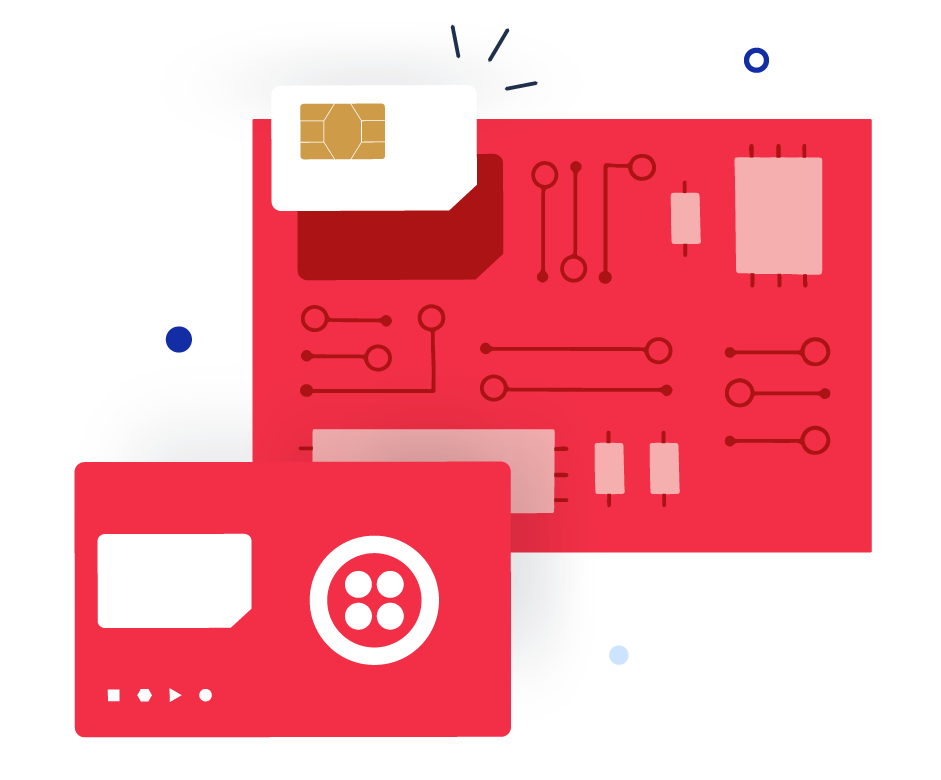
INSIDE THE WHITEPAPER
Introduction & Purpose
The pervasive coverage of cellular networks across the globe creates opportunities for deployment of Internet of Things solutions at scale across wide geographic areas. Unfortunately, for cross-regional or multi-network cellular IoT deployments, having to deal with the complexities of managing multiple carriers slows down your fleet expansion and business growth. In an effort to resolve this, the industry offers several options, but when considering the array of options as a whole, only the Multi-IMSI approach truly provides an optimal solution — it is the key to success of your IoT solution deployment. In this whitepaper, we’ll explore:
-
The strengths and weaknesses of implementing various SIM solutions in an IoT deployment including; multiple local SIMs, an eSIM (a.k.a eUICC SIM), a roaming SIM, or a multi-IMSI SIM;
-
The architectural and standards basis for the strengths and weaknesses of various SIM solutions;
-
How Twilio is offering a superior Multi-IMSI SIM for the highest efficiency in managing global IoT deployments
Note: The term eSIM can be a bit confusing. It can refer to embedded SIMs, i.e. smaller-form-factor SIMs that are pre-soldered onto a circuit board vs. swappable in nature, but also to so-called eUICC SIMs. For the purposes of this white paper, we intend eSIM to mean eUICC SIMs, which will be explained in a later section. See also “What is the Difference between eSIM and Embedded SIM”.
Chapter 1
1
SIMs and the Evolution of Wireless Networks
The Subscriber Identity Module (SIM) securely stores the International Mobile Subscriber Identity (IMSI) and the cryptographic keys that enable a mobile device to identify and authenticate itself on a cellular network. The SIM identifies itself using the IMSI and a cryptographic key, but also via the Integrated Circuit Card Identifier (ICCID), the Issuer Identification Number (IIN), and the Mobile Subscription Identification Number (MSIN) — for purposes of this white paper, we’ll focus on the interaction between the IMSI and the mobile core—the central component of any wireless network controlling authentication and data flow. Definition of standards for SIMs and associated technology was previously handled primarily by the GSM Association (GSMA), but is now handled largely by the Third Generation Partnership Project (3GPP).

Historically, the SIM was implemented in a physically-removable integrated circuit called a SIM card, consisting of a hardware component (the Universal Integrated Circuit Card or UICC) and associated software elements such as the IMSI, the cryptographic keys, as well as dedicated applets running on the SIM that control the SIM’s behavior towards the modem on the device. To accommodate smaller devices and their lack of space, SIMs also exist in embedded form factors, as a permanently-installed integrated circuit (e.g. MFF2). Finally, the GSMA released a SIM type specification that allows an end user, or the device maker, to remotely load and activate SIM profiles, which no longer requires a physical SIM swap; this is known as eUICC. eUICC SIMs can come in any form factor, including 2FF, 3FF, 4FF, and MFF2, but it makes most sense to pre-solder them onto a circuit board to make them more robust. Since the SIM profile is now separated from the hardware in the device, makers of IoT devices with a long deployment life are no longer burdened with supporting legacy carrier or network operator configurations that existed at design time.
Today, the wide range of hardware and software platforms for subscriber identification creates flexibility and opportunities for innovation, but each combination has benefits and drawbacks that must be considered — especially because SIMs were developed for handsets, not battery-powered connected sensors that might live for years untouched in remote areas. In general, when taking an IoT solution to market using a cellular data network, your network connectivity choices for cross-carrier deployments are:
-
Multiple local SIMs, each with a single IMSI for a particular carrier/network;
-
A Roaming SIM: a single physical SIM with a single IMSI, but one that grants access to many networks via carrier roaming agreements;
-
An eSIM (aka eUICC SIM): can hold one or multiple digital SIM profiles, downloaded to the device over the air;
-
A Multi-IMSI SIM
A Multi-IMSI SIM is a single SIM profile (coming either on a single physical SIM, or as a digital profile on an eSIM) but with the added benefit of holding multiple IMSIs. To understand the benefits of Multi-IMSI SIMs, we need to first understand what SIMs do, and how the different approaches the industry has proposed to date work.
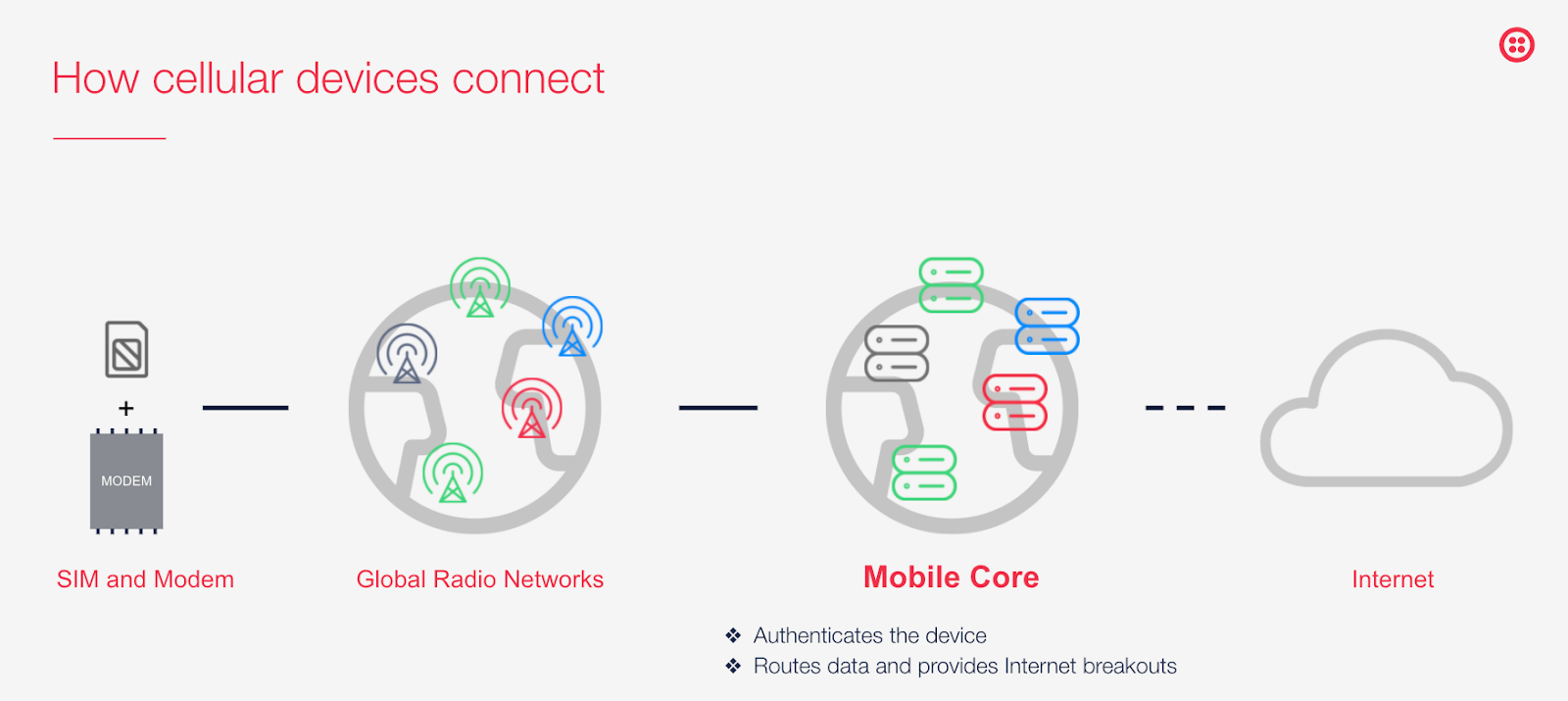
The device’s SIM is an integral part of this connection — it stores unique cryptographic keys and identifiers necessary to identify the device to the network, but it is the modem that performs and maintains the actual connection. Because no device can join and operate on a cellular data network without a SIM it logically follows that proper selection of a SIM strategy and implementation are critical to guarantee the success of any cellular IoT project.
Chapter 2
2
Cellular Radio Access Types (RATs) for the Internet of Things
In order to understand why proper choices for SIMs, IMSIs, and mobile cores are so important when considering options for IoT deployments, it helps to understand the history of cellular networks, and how those networks evolved from something originally intended for voice communications to the broadband and high-density voice and data networks we enjoy today.
In the early days of cellular, the switch from first-generation analog to second-generation (2G) digital air interfaces (IS-54 and IS-136) enabled a rudimentary data connection called Short Message Service (SMS, the basis for our ubiquitous “texting”) over the 2G signaling channel. SMS, while limited in data throughput, proved quite useful for low-throughput telemetry applications that don’t require high data rates. For example, alarm companies were early adopters of SMS as either a primary or backup connection method to link customer equipment with security monitoring services. While its implementation in the signaling and control plane prevents SMS from being a high-throughput data service, it remains a core function of the cellular data network, persisting even as we enter the era of fifth-generation (5G) networks.
Later generations of cellular added support for data connections in the user plane. Beginning with third-generation (3G) cellular, the International Telecommunications Union’s Radiocommunications Sector (ITU-R) began setting the definition for cellular generations, including minimum requirements for data rates. Technologies defined by various standards bodies, primarily the Third Generation Partnership Project (3GPP), were created to meet the ITU-R definitions. For example, 3GPP created the Universal Mobile Telecommunications System (UMTS) technology as a candidate to meet the IMT-2000 (popularly known as 3G) definition. UMTS offered user data rates up to 2 Megabits per second in ideal conditions, however in practice users experienced data rates in the range of 300 – 500 kilobits per second. Nevertheless, these data rates were orders of magnitude higher than 2G, and thus 3G enabled the emergence of mobile email, mobile web, and limited mobile media — it also enabled a wide variety of connected devices including vehicle location and personal safety trackers. More and more IoT devices now connect via fourth-generation (4G) networks, primarily via Long Term Evolution (LTE) networks.
The fifth-generation (5G) of cellular technology has begun deployment, with ultra low latency and very high bandwidth being key aspects of the new standard. However, for the vast majority of IoT use cases, neither is a requirement, so the development of 5G is less relevant for IoT than it is for consumer use, with the exception of its support for high density of devices in a small region.
While they can be — and are — used for IoT applications, cellular data radios (2G/3G/4G) designed for mobile phones are not very power efficient, and are thus not always optimal for battery-powered Internet of Things deployments. In response, the industry developed Narrowband IoT (NB-IoT) and LTE Cat M (also known as LTE-M) which consists of the current Cat M1 and the emergent Cat M2 variant, both of which enable deployment of battery-powered devices that can operate for months or years without intervention.
Chapter 3
3
The Evolution of SIM Solutions for Multi-Carrier Deployments
To reduce inventory, logistical, and support complexities, IoT devices must be able to move easily and flexibly between carrier networks, and do so without much of any human intervention. In this section we’ll look at some options for creating that flexibility. IoT devices must be able to connect to cellular networks without user intervention.
Let’s use a shared mobility scooter as an example to illustrate how this works. Obviously, with a large number of scooters operating in the field, the fleet operator wants to avoid customer support questions and a poor user experience, and maximize revenue by getting more passengers on scooters. To better understand this, we need to look at the role different types of SIMs and carrier agreements play in creating and sustaining connectivity for an IoT device.
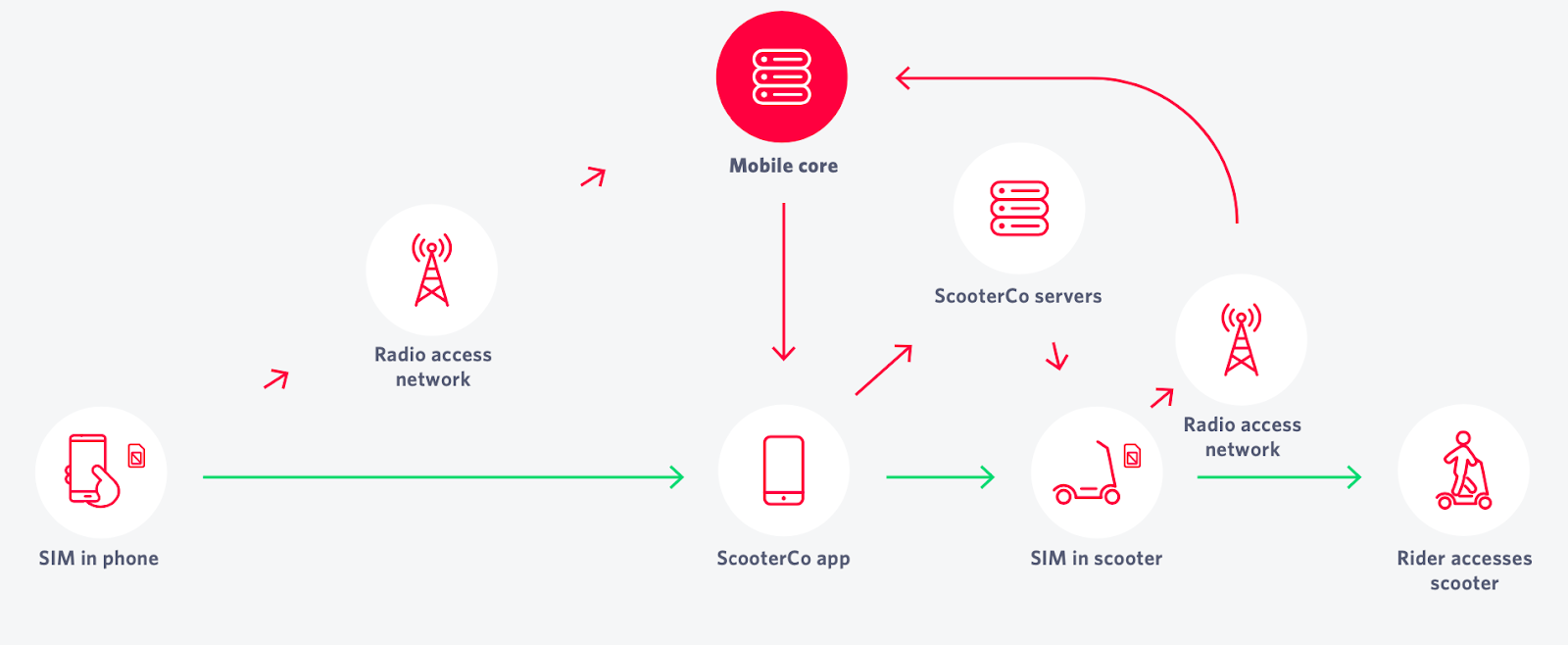
Local SIMs
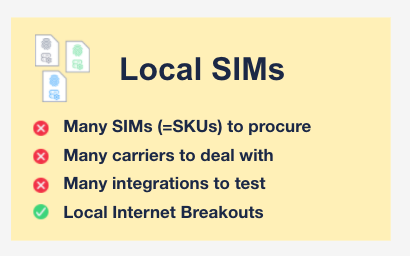
IoT devices usually must be able to connect to cellular networks without user intervention. To deploy devices to new regions or countries, IoT solution providers using local SIMs must physically swap SIM cards on each device, and manage a complex inventory of SIMs for the various cellular networks where the IoT devices will operate – sometimes in many dozens of countries. While being a simple way to access a cellular network, local SIMs lock the device to a single carrier and cannot roam.
When the scooter’s onboard systems power up, the modem scans for available networks and communicates the scooter’s location to the SIM, in the form of the MCC (Mobile Country Code); e.g., 460 is the MCC for China. It is up to the SIM subsystem to utilize this information. If the SIM only stores one IMSI — as is the case with all traditional local SIMs — it provides this IMSI back to the modem, together with the cryptographic keys, and the modem in turn communicates this data to the cellular network. If the scooter currently resides in the SIM provider’s home country, known as the Home Public Land Mobile Network (HPLMN), it is ready to “attach” to the network and provide data connectivity for the device.
When the device moves out of range of its Home PLMN, it connects to Visited PLMNs (VPLMNs) in the carrier’s network. It now has no credentials authorizing it to connect, resulting in a loss of connectivity altogether.
Roaming SIMs
Roaming SIMs are SIMs from a single provider, holding an IMSI that grants access to a whole list of international networks Via inter-carrier contractual agreements, these SIMs allow roaming from one network to another. Many carriers offer such support for roaming onto networks outside their region or country. In a perfect world, global permanent roaming would be the solution, and there would be no need for alternatives. In practice, and for several reasons, global permanent roaming is not possible. In some countries, permanent roaming is prohibited by law — the regulatory agencies in some countries limit the amount of time a device can roam on its carriers’ networks. For example; India, Turkey, Canada, and Brazil all have restrictions against permanent roaming. Even if a country does allow permanent roaming, the political profile of that country could change over time and the country’s policies on permanent roaming may change in the future.
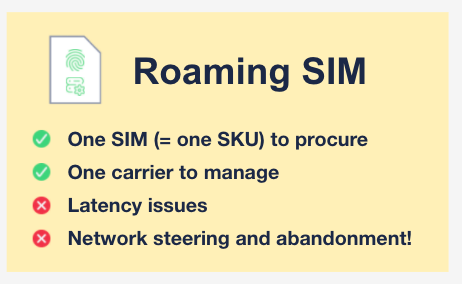
Roaming SIMs have the additional – and for IoT use cases severe – drawback of being at the mercy of the home provider. First, the provider usually only offers one single network per country – and only their own network in the home country. For US carriers, e.g., that would result in getting access to only T-Mobile, or only AT&T, and then only, say, Vodafone in the UK. While that might be acceptable for consumer devices, it can completely break IoT use cases as it can result in poor or no coverage in some areas. Second, the roaming agreements outside of their home turf can change, and your devices might be steered to networks with poorer coverage, or networks that operate on bands your modem isn’t ready for. This is called network steering, and would result in complete loss of connectivity.
Finally, roaming SIMs force the IoT device to route data through the home network core. Given the physical distances across which data may need to transit, this type of data routing can result in significant and – for some use cases – unacceptable latency. Routing data over long distances and multiple networks also increases the possibility of data loss, another potential contributor to a poor user experience. Finally, data crossing more borders means a lack of data sovereignty, which may also be a showstopper based on the region’s legislation.
eSIMs / eUICC SIMs
eSIMs (eUICC SIMs) are a relatively new standard defined by the GSMA. They can come in the form of swappable SIM form factors, or pre-soldered embedded SIMs, but usually come as the latter. These SIMs allow storing multiple SIM profiles on a single chip. For the first time, IoT device makers can now decouple the selection of their cellular provider from the SIM hardware itself, resulting in more freedom down the road; selections made at design time are no longer holding you back from switching your provider, say, a few years after deployment. With eSIM, devices can be triggered to download SIM profiles over the air. If an IoT device using this type of SIM moves from one country to another, it can be instructed to switch to another local carrier and download / activate that provider’s profile.
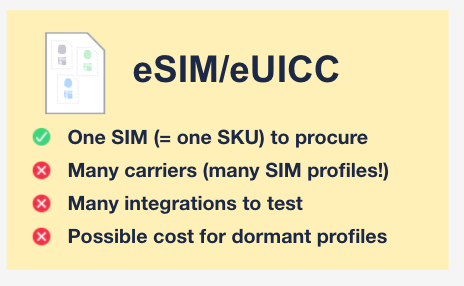
While this sounds like an elegant solution at first – like with roaming SIMs, we’re again dealing with a single SIM only –, it comes with its own set of problems. Each SIM profile stored on the SIM essentially acts like a local SIM. Each SIM profile stored on the eSIM needs to be sourced independently, requiring negotiations with multiple carriers or resellers. Furthermore, each SIM will instruct the modem to connect to the mobile core of the local provider, which results in multiplied integration and testing efforts. What’s more, you might be paying fees for any dormant profiles, since only one profile is ever active at a time.
Many current providers of eSIMs also choose an architecture (called M2M eSIM) that relies on a cloud server to switch the profile. This counteracts to some degree the very point of the eUICC principle: being able to switch the connectivity providers at will over the lifetime of a device. The architecture giving you more flexibility and ultimately the freedom to own your own cellular destiny is called Consumer Profiles. With this, the logic for switching a profile sits on the device itself (or the SIM), eliminating the dependency on yet another vendor-provided cloud server (or having to operate and maintain your own.)
For all the reasons stated above, eSIMs are still not the final answer to the challenges of multi-carrier cellular IoT deployments. That changes, however, with Multi-IMSI SIMs.
Chapter 4
4
The Benefits of
Multi-IMSI SIMs
So far we’ve looked at:
-
Local SIMs: Multiple physical SIMs created for each local region and carrier. The issues with using Local SIMs are numerous.
-
Roaming SIMs: A single SIM, with carrier roaming agreements. This solution encounters challenges around network control, international economics, and even geopolitics.
-
eUICC eSIMs (aka eSIMs): More flexible than traditional SIMs, but by themselves do not support the flexibility needed for multi-carrier IoT deployments.
Multi-IMSI SIMs are the key to unlocking success in multi-carrier IoT deployments. To understand why, first we need to understand the typical architecture of a Multi-IMSI SIM.
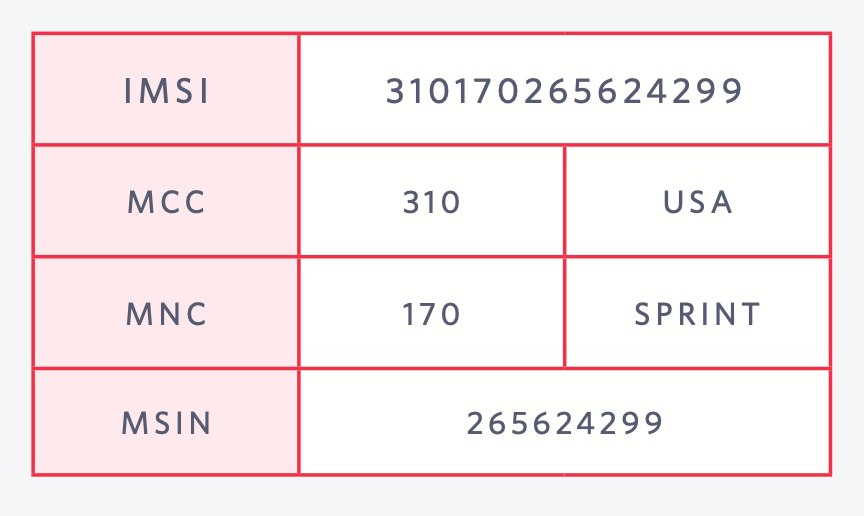
The International Mobile Subscriber Identity (IMSI) is a string of digits that uniquely identifies each SIM to the serving networks. It consists of a Mobile Country Code (MCC), a Mobile Network Code (MNC), and a Mobile Subscriber Identity Number (MSIN). Together, these form the IMSI.
In what may seem like a very obvious statement, Multi-IMSI SIMs are able to store multiple IMSIs on one SIM profile — we can think of them as a key ring, loaded with keys to multiple cellular networks. But these SIMs are still single SIMs, from one vendor, who typically operates their own mobile core network.
In some cases, Multi-IMSI SIMs contain local network IMSIs to work around issues with permanent roaming in countries where that’s disallowed. In other cases, Multi-IMSI SIMs give both local and roaming access to dozens or hundreds of networks, together forming an overlapping list of networks that has redundancy built in. This latter use case can be viewed as “multiple roaming SIMs in one”, but implemented as a single SIM profile, which comes with significant advantages. These make Multi-IMSI SIMs the best choice for unlocking success in IoT solutions deployed across multiple cellular data networks, as we will soon see.
The key to the multi-IMSI architecture lies in the interplay between the SIM and the modem. A typical interplay of Multi-IMSI SIM and modem throughout the journey of an IoT device looks like this:
-
Device wakes up where it got manufactured. Modem scans for networks, reports location (MCC, e.g. 460 for China) to the SIM.
-
Based on the MCC, SIM presents preferred IMSI back to modem. Modem establishes connection with preferred network from SIM-based PLMN priority list. No fees charged yet.
-
Modem experiences drop of connection. Automatically presents same IMSI to other available network and successfully connects to a different network.
-
Device now gets deployed to country of operation. The modem is unable to connect to any of the visible networks, enters “limited service” mode and continually reports that status to the SIM.
-
SIM starts a 3-minute timer to track how long the modem is without connectivity. When expired, SIM switches the IMSI and issues a REFRESH command, forcing the modem to re-read the new IMSI and attempt connection. This continues until the modem reports it has service
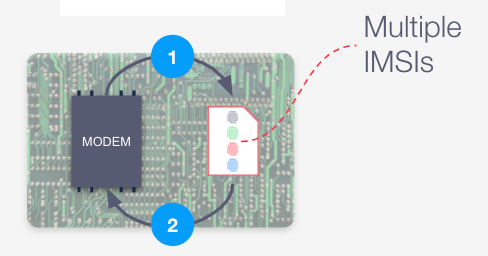
To get the full benefit of this technology and achieve seamless global operation of an IoT solution and reduce logistical and performance overhead, we must pair it with a distributed IoT mobile core. While having multiple IMSIs available on the SIM allows an IoT device to unlock connections to cellular networks in various regions and countries around the world, the core can’t be in a single location alone. Given the physical distances across which data may need to transit, latencies or packet loss can break use cases, and data crossing more borders also means a lack of data sovereignty.
A distributed IoT mobile core is created in the cloud, operated on high-availability servers located in various cloud zones around the world. It’s a single code base, which eliminates the need for testing device integrations multiple times, as different cores come with different network configuration (e.g. timeouts, or routing prioritizations.)
Because the distributed IoT mobile core is architected specifically to support IoT devices, versus traditional carrier-provided mobile cores designed for general purpose use, the Multi-IMSI SIM is the key to unlocking higher levels of performance, flexibility, and scalability when deploying a global IoT solution.
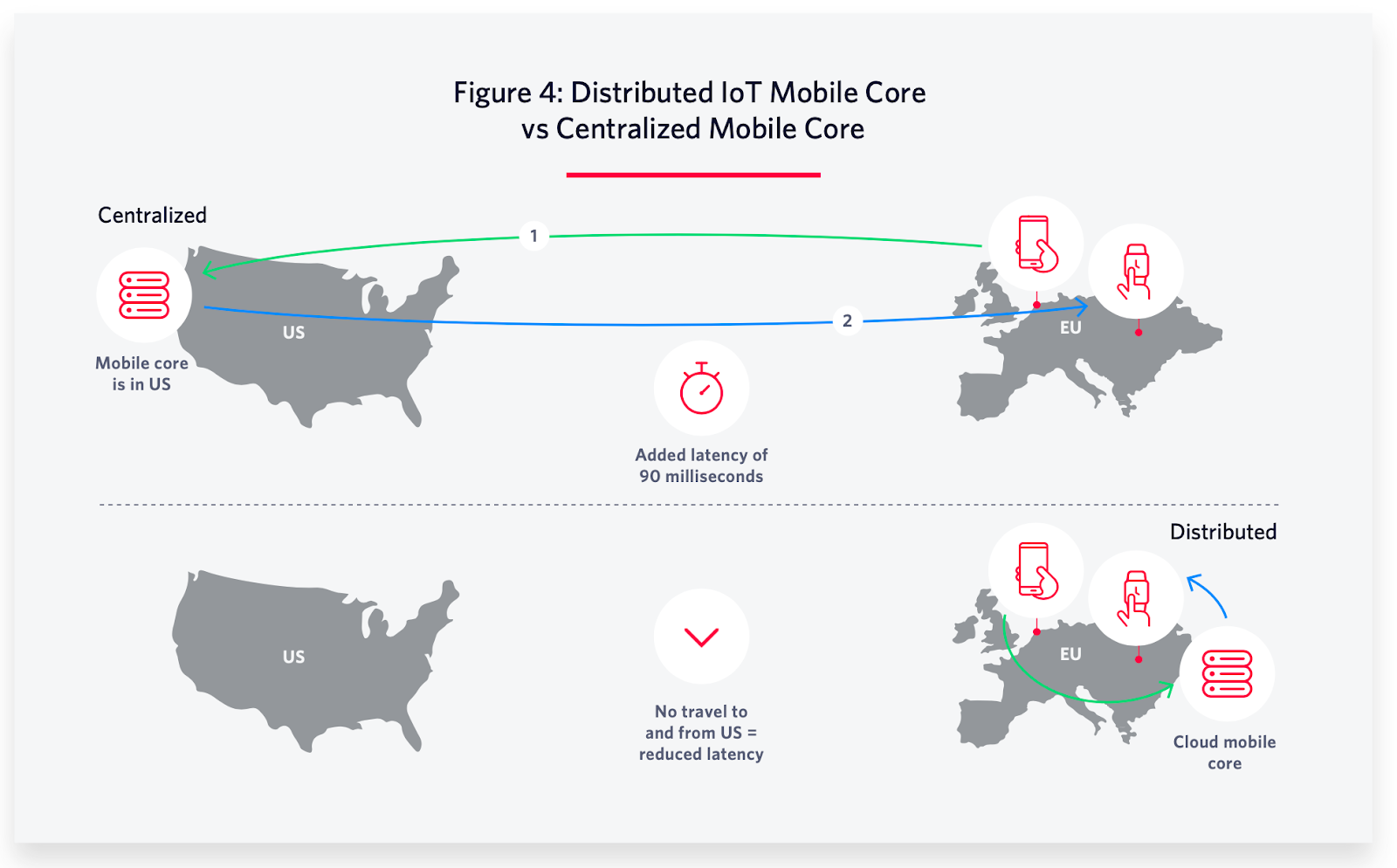
Multi-IMSI SIM Advantages
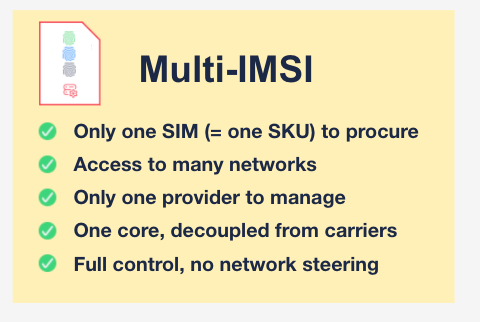
Multi-IMSI SIMs provide the best of all worlds: a truly single SIM with access to hundreds of networks from one provider, who optimally offers a single distributed mobile core, giving you full control over your network selections and no network steering.
What’s more, multi-IMSI SIMs give you network redundancy. With roaming SIMs and eSIMs, you either have no choice at all in an individual country or region and get only one network to connect to, or you need to go through hoops to switch profiles actively. Outages of individual networks usually mean lost connectivity altogether. Multi-IMSI SIMs give you multiple paths for your data to reach your business, and any failures in downstream providers can be routed around – optimally in a fully automatic fashion.
Note that Multi-IMSI SIMs can be downloaded as digital SIMs onto eSIM hardware, so that IoT solution providers can benefit from the Multi-IMSI advantages while still retaining the freedom to load other profiles onto their hardware as necessary.
Chapter 5
5
Twilio Super SIM offers a purpose-built IoT solution using Multi-IMSI SIMs and Distributed IoT Mobile Cores
Twilio is a household name in the communications industry and has been working on democratizing access to complex telecom infrastructure and functionality for over 12 years. Today, they offer the leading programmable IoT SIM with Twilio Super SIM.
Super SIM is a Multi-IMSI SIM providing all of the benefits explained earlier in this piece. That includes the ability to automatically switch IMSI based on device location, and also automatically failover in case of a network outage. It can be loaded as a Consumer profile on eSIMs, which allows you to combine the benefits of both approaches. It has robust and well-documented APIs for high operational efficiency, as outlined here. Twilio can update all Super SIMs over the air, to push new IMSIs or improve general SIM functionality. It leverages a Mobile Core built by Twilio, not outsourced, and is for IoT only and thus optimized for it. The core is deployed around the world for consistently lower latencies and better data sovereignty.
Beyond the technical aspects of Super SIM, Twilio also offers easy access to their experts and comprehensive self-help resources. Twilio is a cloud company with software DNA – not a carrier, not a reseller. To understand the implications of this better, have a look at this explainer video:
Finally, Twilio offers additional IoT capabilities not often found out of the hands of one single provider, such as embedded voice and video for push-to-talk IoT devices and messaging APIs for customer or staff notifications and alerts

